
IRIS login | Reed College home Volume 96, No. 2: June 2017
Working Weekend Connects Seekers with Knowers
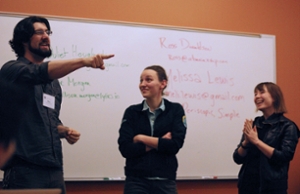
Building a career is dependent on both what you know and whom you know, as Reed’s fourth annual Working Weekend proved. The event, organized by the Center for Life Beyond Reed, attracted a record 336 students and young alumni who came to network with more experienced alumni and gain job-seeking skills.
Reed alumni created Working Weekend three years ago to help students transition from college to career. The two-day event brings alumni panelists from around the country to mentor students, answer questions and provide a window on the world of careers such as banking, law, medicine, technology, music, writing, and food.
The campus buzzed with notable alumni, including:
Continue reading Working Weekend Connects Seekers with Knowers
Bio Prof Wins $444K Grant from NIH
Prof. Erik Zornik [biology 2012–] has been awarded a $444,000 grant from the National Institutes of Health to support his research on mechanisms in the brain that generate rhythmic behavior—with the goal of finding new treatments for neurological disorders.
Prof. Zornik is interested in how behavioral variation is encoded in neural circuits. His research investigates a hindbrain central pattern generator (CPG) that generates the courtship vocal behaviors of African clawed frogs, Xenopus laevis.
“Adults of this species exhibit a rich vocal repertoire of at least seven call types that range from rhythmically simple to temporally complex,” Zornik explains. “Xenopus vocalizations are sexually differentiated; males and females produce calls with distinct temporal characteristics that are regulated by steroid hormones during development and in adulthood. This makes their vocal behaviors an ideal subject for understanding the neural basis of behavior and behavioral plasticity.”
Continue reading Bio Prof Wins $444K Grant from NIH
Philosophy, Star Trek, and the Glass Plate Game
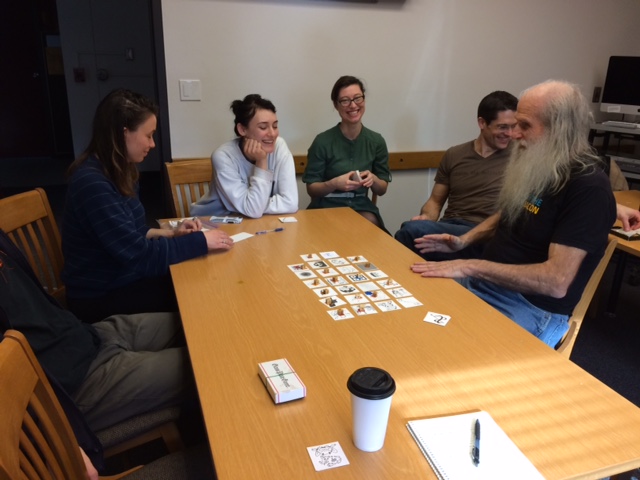
There were nine of us gathered in the classroom in Vollum. We chatted in hushed tones among coffee cups with brown rims and the winter sunlight filtering in through the blinds. We were alert, we were prepared—although a few late stragglers had the distinct look of an unmade bed—and we began.
We started with Species-Specific Norms, and reasoned our way to The Need Not to Judge and from there Emergence. After a discussion of the philosophical underpinnings of the Star Trek episode “The City on the Edge of Forever,” we rejected Emergence as a suitable logical connection with The Need Not to Judge. Instead, someone posited Nature Tending Towards Perfection, which we accepted. Someone else posited Death as a counterargument, which led us to Emotional Manipulation, Unwanted Relationships, Agency, Music, and, finally, Hidden Potential.
Though it might sound like we were crowdsourcing a philosophy paper, we were in fact playing a round of the Glass Plate Game. The game has no winner or loser, and no score is kept. Instead, players engage in cooperative reasoning, and progress across a series of cards covering different topics.
Continue reading Philosophy, Star Trek, and the Glass Plate Game
Life of the Mind (and Legs)

People often ask me what today’s Reed students are like. A dozen adjectives spring to mind. They are brilliant, creative, curious, passionate, idealistic, committed, intellectual, and iconoclastic. And yet there remains an elusive X-factor about them that seems impossible to capture, no matter how many times I scan the thesaurus.
From time to time, however, I stumble across something that conveys something of the essence of Reed. Today it is a running log that was kept by Russian major Timmy Straw ’17 last quarter for a PE class. As readers may know, all Reed students have to complete six quarters of physical education; for the running class, they’re supposed to maintain a log of their runs. This is strictly a bookkeeping requirement, akin to logging hours on a timesheet.
In true Reed fashion, however, Timmy took a mundane assignment and turned it into a virtual art form.
Continue reading Life of the Mind (and Legs)
Reed Declares New Majors

The perennial sophomore’s dilemma—What should I major in?—just got harder.
In November, the faculty voted to broaden Reed’s curriculum by approving a new major in comparative literature, and two new concentrations in the mathematics department: mathematics-computer science and mathematics-statistics. All three tracks will be in place by fall 2015. (And it looks like a standalone dance major is also on the way.)
The mathematics-computer science concentration may seem like the most radical addition. After all, are computers really compatible with Reed’s emphasis on the humanities? The answer is a resounding yes. Reed has pioneered the use of computing in the liberal arts and sciences amid growing recognition that computer science constitutes a distinct intellectual discipline, bristling with unsolved problems, theoretical debates, and recursive paradoxes.
Continue reading Reed Declares New Majors
Film Focuses on Enigmatic Psychologist
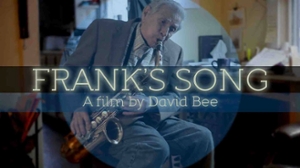
Like a jazz movement, the new documentary Frank’s Song, by Portland filmmaker David Bee, is at times languid, at others staccato, and sometimes a little drawn out.
Truth is, it’s a tall order for any film to capture the protean life of Frank Wesley ’50, who survived the holocaust, worked in the shipyards, became an influential psychologist and author of many books, and still, at the age of 95, cuts a distinctive figure in the Hawthorne district of southeast Portland.
Frank also is obsessed with jazz. The grizzled, diminutive, always-smiling nonagenarian is often caught on camera sitting in a chair, clutching and absentmindedly repositioning his brass wind instrument, much like a father with an infant. That is, when he’s not blowing into his sax with everything he’s got. “Jazz doesn’t let me die,” he says in his accented, soprano English.
Continue reading Film Focuses on Enigmatic Psychologist
Jump for Joy! Reed Wins $800K Grant for Dance

Reed has won an $800,000 grant from the Andrew W. Mellon Foundation to strengthen its dance program with more classes, more workshops, and—pending approval from the faculty—a freestanding dance major.
“I am thrilled by what the Mellon Foundation's support will mean for dance at Reed,” says Prof. Carla Mann ’81 [dance 1995–].
The grant will allow the college to expand faculty positions in the dance department from 2 to 2.5, enabling professors to teach 12–13 courses a year. It also sets the stage for us to offer a dance major—something Reed dancers have long hoped for. Reed will launch a search for a new tenure-track professor to begin in the fall of 2015. After that, the dance department, including Prof. Mann and Prof. Minh Tran, will devise and propose a major. If the faculty approves, Reed would be the only college in Portland that offers a dance major (although Lewis & Clark and Portland State University both offer a dance minor).
Continue reading Jump for Joy! Reed Wins $800K Grant for Dance
Reed Prof Lends Voice to Torture Debate
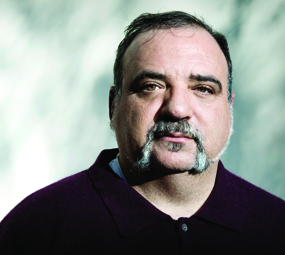
The Senate Intelligence Committee’s investigation into the use of “enhanced interrogation” by the CIA has sparked a national debate on the role of torture—a debate in which the voice of Prof. Darius Rejali has grown increasingly prominent.
Prof. Rejali is the author of the influential book Torture and Democracy, and is one of the world’s leading scholars on torture.
Last week, Rejali, Prof. Paul Gronke, and Peter Miller ’06 wrote an article for the Washington Post contending that U.S. opinion is still strongly opposed to the use of torture. "No, Americans aren't 'fine with torture.' They strongly reject it."
Continue reading Reed Prof Lends Voice to Torture Debate
Econ Department Hails “Senior” Student
The Reed economics department threw a party on Friday for lifelong student Lys Carney, a retired businessman who has audited a jaw-dropping total of 19 econ classes—the most in the department’s history.
Lys was already retired in 2005 when he took his first class at Reed, ECON 348, Economics in the Public Sector, with Prof. Noelwah Netusil. “I decided to study what I should have known all the time when I was in business,” he said. “I had a lot of experience, but I never knew the theory.”
He then proceeded to audit one class each semester for the next 10 years for a grand total of 19 (plus one class in the history of science with Prof. Ralph Drayton ’87.)
Continue reading Econ Department Hails “Senior” Student
How to Conquer the Number Plane
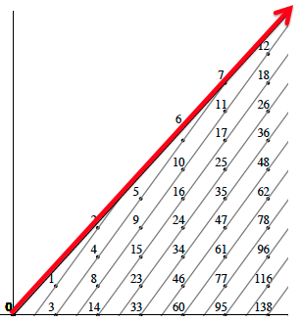
Imagine dashing into a vast, Borgesian concert hall just before the curtain rises. There’s an infinite number of guests and an infinite number of seats, neatly arranged in rows and columns. Unfortunately, a mischievous hobgoblin has roped off a section of the auditorium with a velvet cord, putting some seats out of commission. How do you, Guest N, figure out where to sit?
Okay, it’s a far-fetched scenario, but math major Maddie Brandt ’15 is the first person in history to solve it in her paper “Quadratic Packing Polynomials On Sectors Of R2,” which she will present at a national conference in January.
The problem of assigning guests to seats is directly related to the problem of mapping the non-negative integers (those friendly, deceptively familiar objects such as 0,1,2,3, and their ilk) onto the co-ordinate plane (defined by pairs of integers such (0,0), (0,1), (0,2), etc.—think of the game of battleships). How do you map the integers to the co-ordinate pairs in such a way that you count all the pairs one after another, without skipping any?
Continue reading How to Conquer the Number Plane
Eye of the Zebra (fish)
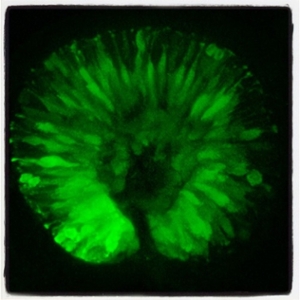
Reed made a big splash at the annual Murdock College Science Research Conference in Vancouver, Washington, this month. Prof. Kara Cerveny [biology 2012–] and three students, Alison Bryant ’15, Will Horner ’15, and McKenzie Givens ’17 presented the results of their summer research. We’re proud to announce that Will earned the John Van Zytveld Award in The Life Sciences for his explanation of how retinoic acid influences retinal growth and neurogenesis in the zebrafish retina.
Students in Prof. Cerveny’s lab explore fundamental questions such as how a single cell becomes a complex organism, how undifferentiated cells choose their fate, and why some tissues regenerate after injury-- all through studying zebrafish eye and brain development.
Continue reading Eye of the Zebra (fish)
Congrats, Prof. Corpus!
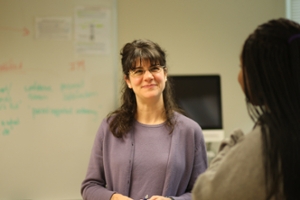
Prof. Jennifer Henderlong Corpus [psychology 2001-] was named 2014 Oregon Professor of the Year last week by the Carnegie Foundation for the Advancement of Teaching in recognition of her innovative approach to teaching and learning and her ability to challenge students beyond the classroom.
“Each of our awardees, state and national, brings extraordinary leadership not just to their classrooms, but to their departments, colleges and universities, and their respective professional fields,” said Anthony S. Bryk, president of CFAT. “We honor them for upholding and guiding the aspirations of their students, advancing knowledge, and elevating and dignifying the profession of teaching. In recognizing their commitment and excellence, their contributions and their demonstrated passion, we support the centrality of teaching on campus and recognize its importance to the future of our country.”
Judges selected the national and state winners based on four criteria: impact on and involvement with undergraduate students; scholarly approach to teaching and learning; contributions to undergraduate education in the institution, community, and profession; and support from colleagues and current and former students.
Continue reading Congrats, Prof. Corpus!
Software Studio Says “Hello, World!”

Codeslingers, limber up your fingers! Reed is getting ready to launch the new Software Design Studio (SDS) in January.
Bunkered in the basement of Prexy, the SDS will offer hands-on instruction and thoughtful mentorship to help Reed students explore the art and craft of coding.
Many students learn how to write code during their coursework in physics or mathematics, but the SDS is designed to bolster programming skills with practical experience directed by a technologist in residence. It is also aimed at students majoring in disciplines such as classics, music, art, or political science, who have never written a line of code, but are intrigued by the intellectual challenge.
Continue reading Software Studio Says “Hello, World!”
Freshman, Undefeated, Wins Fencing Tourney
Bio major Ryan Kwok ’18 emerged victorious from the 17th annual Douglas Williams Fencing Tournament last Saturday after winning all of his six bouts. Ryan was awarded a gold pendant, shaped like a fencing foil, amidst applause from his fellow sword-fighters.
The tournament took place in the sports center, where professors, students, and parents visiting for Parent & Family Weekend gathered to cheer as the deft exchanges between the combatants resounded in steely echoes across the auditorium. The contestants displayed excellent sportsmanship by exchanging hearty handshakes and high-fives between each bout.
Continue reading Freshman, Undefeated, Wins Fencing Tourney
In the Presence of a Poet
While growing up in rural New England, “the world I explored was in books,” says poet Lisa Steinman, Reed’s Kenan Professor of English & Humanities [1976–], who remembers as early as nursery school “looking at a page one day, and it just made sense.”
Now she writes poems “to make sense of myself and the world,” she says. “I also love playing with the sounds of words, and I’d like to think I give other people the pleasure I’ve gotten from poetry.”
Prof. Steinman will do just that when she reads from her latest poetry collection (her ninth book), Absence & Presence (University of Tampa Press, 2013) at 6 p.m. on November 14, 2014 at Portland’s Glyph Café & Art Space.
Continue reading In the Presence of a Poet
Reedie fights Ebola in Liberia
Sheldon Yett ’86 got two hours of sleep last night and now, as ambulances scream by his office window in Monrovia, he’s worried about the three emergency responders he just sent out into remote northeast Liberia, to distribute medical and infection control supplies to a village. “Do they have enough chlorine?” he wonders, “Enough rehydration supplies?”
Tomorrow morning, Sheldon will leave the Liberian capital in a helicopter, bound for another remote village, to discuss crisis health care with community leaders. Meanwhile, visitors flow into Liberia—Samantha Power, the U.S. ambassador to the United Nations; Dr. Paul Farmer, the founder of Partners in Health; and Borge Brende, the foreign minister of Norway. Visitors to Sheldon’s office must stop by a bucket filled with a chlorine solution to wash their hands and have their temperature checked as a guard stands watching. The electricity and the internet flickers, and in a brief moment of respite, Sheldon stares blankly into the Skype camera on his computer, rubbing his temples. “I’ve never worked so hard in my life,” he says.
Continue reading Reedie fights Ebola in Liberia
<i>Shades of White:</i> Elegant, Geometrical, and Chilling
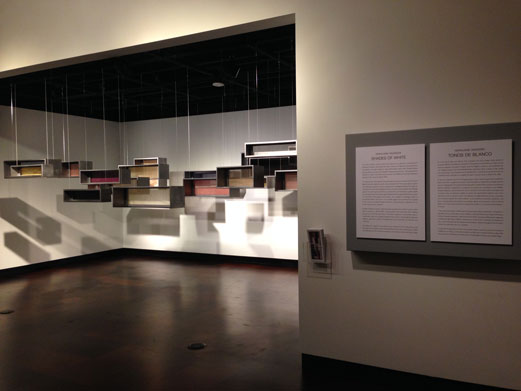
Prof. Geraldine Ondrizek’s thought-provoking exhibition, Shades of White, is as beautiful to look at as it is unsettling to think about. Dramatically installed in the Artist Project Space of the Jordan Schnitzer Museum of Art (University of Oregon), the show exudes minimalist cool: 24 steel boxes suspended from the ceiling by metal wires, each box backed with silk panels in muted hues. With its armada of suave, industrial rectangles seemingly floating midair, it looks like a long-lost Donald Judd installation that somehow wound up in a zero gravity chamber. But there is far more at play here than elegant geometry for its own sake; Prof. Ondrizek has created a sobering meditation on a social injustice perpetrated not only in Nazi Germany, but also in the United States.
Continue reading <i>Shades of White:</i> Elegant, Geometrical, and Chilling
Reed Runners Attack Klickitat
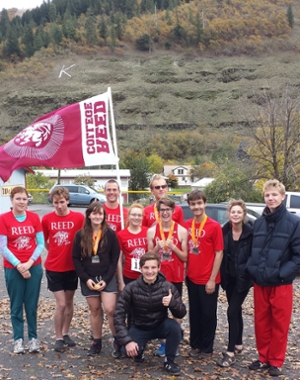
A scrappy band of Reed runners ventured into the Columbia Gorge last weekend for the Klickitat Trail Half-Marathon and 5K Run.
The course was spectacular—and brutal, winding along the sinuous Klickitat River, whose jagged basalt made short work of aching calves and noble intentions.
Freshman Natalie Hawkins ’18 took first place in the women's 5K and chemistry major Anton Zaytsev ’18 nabbed second place in the men's 5K.
Physics major Trevor Soucy ’18 led the Reed pack in the Half-Marathon, coming in fourth overall with an impressive 1:32:12, followed by history major John Young ’15 at 1:36:05, Chinese major Aaron Finsrud ’15 at 1:39:28, and physics major Jack Flowers ’15 at 1:46:44.
Continue reading Reed Runners Attack Klickitat
Cracking Eggs with Physics Majors
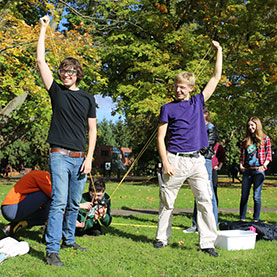
Making my way to the library the other day I came upon an intriguing sight: a dozen students in Physics 101 firing eggs across the Great Lawn with a makeshift slingshot.
The students were applying the principle of conservation of energy to a devilish problem—determining the minimum angle of trajectory required to be sure that an egg will actually smash when it hits the ground.
At first glance, the experimental apparatus—some sturdy forearms and a length of surgical tubing—seemed rather primitive. But in physics, as elsewhere, appearances are often deceptive. It turns out that only four measurements are required for this investigation. First, the angle at which the egg is fired into the air. Second, the distance between the launch site and the landing site. Third, the mass of the egg. Fourth, the height of the grass. Armed with these numbers, the students can calculate the force with which the egg strikes the dirt.
Continue reading Cracking Eggs with Physics Majors
Coho caught spawning in Crystal Springs
Coho spawning in Crystal Springs Creek, downstream from campus, were caught on video for the first time in decades, according to Zac Perry, Reed’s canyon restoration specialist. Although there have been sightings of native salmon and steelhead in the Reed canyon, the fish have not been spied in flagrante delicto until now.
This is a timely occurrence, as Portland is marking the completion of the Westmoreland Park Ecosystem Restoration project on Saturday. The project, which began in May 2012, is a joint effort to remove barriers to fish passage—and it is succeeding in leaps and bounds!
The restoration of Reed canyon is a reflection of the commitment and personnel that the college has made to protect and improve the functions of the last open waterway in the city of Portland, which is now seeing regular visits by both endangered and protected native species seeking refuge in our beautiful headwater forest.
Continue reading Coho caught spawning in Crystal Springs
< Prev 1 2 3 4 5 6 7 8 9 10 11 12 13 14 15 16 17 18 19 20 21 22 23 24 Next >

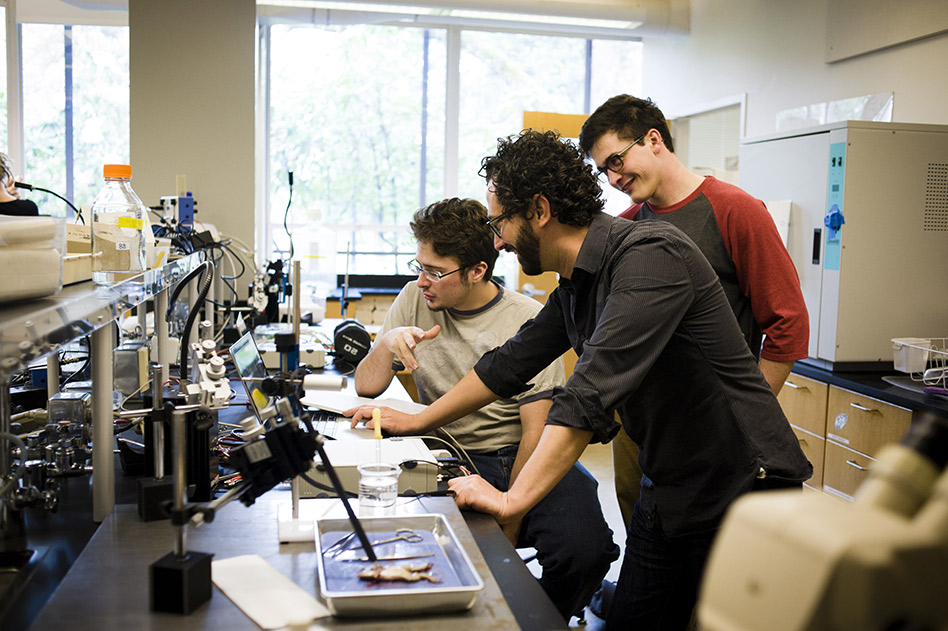
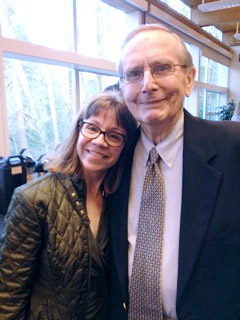

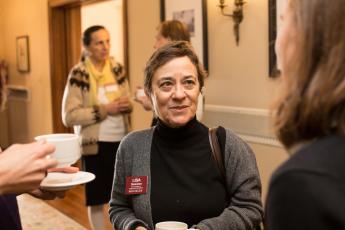
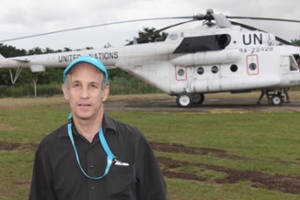


LATEST COMMENTS
steve-jobs-1976 I knew Steve Jobs when he was on the second floor of Quincy. (Fall...
Utnapishtim - 2 weeks ago
Prof. Mason Drukman [political science 1964–70] This is gold, pure gold. God bless, Prof. Drukman.
puredog - 1 month ago
virginia-davis-1965 Such a good friend & compatriot in the day of Satyricon...
czarchasm - 4 months ago
John Peara Baba 1990 John died of a broken heart from losing his mom and then his...
kodachrome - 7 months ago
Carol Sawyer 1962 Who wrote this obit? I'm writing something about Carol Sawyer...
MsLaurie Pepper - 8 months ago
William W. Wissman MAT 1969 ...and THREE sisters. Sabra, the oldest, Mary, the middle, and...
riclf - 10 months ago